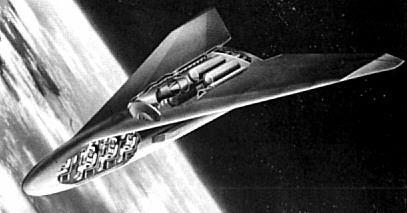Astrocommuter (original) (raw)

Home - Search - Browse - Alphabetic Index: 0- 1- 2- 3- 4- 5- 6- 7- 8- 9
A- B- C- D- E- F- G- H- I- J- K- L- M- N- O- P- Q- R- S- T- U- V- W- X- Y- Z
Astrocommuter

Lockheed Shuttle
Lockheed 1963 Space Shuttle
American manned spaceplane. The Lockheed Astrocommuter was a 1963 design for a manned space shuttle that would use the Saturn 1B as a first stage.
Status: Design 1963. Height: 14.00 m (45.00 ft). Span: 8.63 m (28.31 ft).
Although the engineer who designed it was confident that the vehicle could be developed and made operational in a short time, his project never gained much interest from NASA, the USAF, or even from his superiors at Lockheed.
The Astrocommuter was designed in 1963 by Saunders Kramer at Lockheed. The spaceplane was intended for use as the logistics vehicle for the Lockheed 1963 Space Station. The winged vehicle would have been 14 m long with an 8.63 m wingspan, and would fly to a wheeled landing at a conventional airfield after re-entry. Viewing for the pilot was be provided by a periscope-like device,. It was powered in the subsonic flight regime by two turbojet engines, and provided with enough jet fuel for a 48-minute endurance, equivalent to a range of 574 km. A Saturn IB first stage would boost the spaceplane into the stratosphere, after which its own rocket engines would take it the rest of the way to orbit. Kramer estimated the development cost as $135 million, and claimed a first flight would be possible as early as 1966. However there was no support within Lockheed to push the concept outside of the company.
Family: Space station orbit, Spaceplane, US Rocketplanes. Country: USA. Agency: Lockheed.
Home - Search - Browse - Alphabetic Index: 0- 1- 2- 3- 4- 5- 6- 7- 8- 9
A- B- C- D- E- F- G- H- I- J- K- L- M- N- O- P- Q- R- S- T- U- V- W- X- Y- Z
© 1997-2019 Mark Wade - Contact
© / Conditions for Use